
7/9/04
Returning To The Biggest Little Car Collection In The World
Part 2
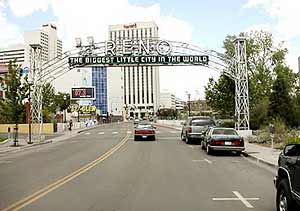 The National Automobile Museum is located just off the right edge of this photo, on the banks of the Truckee River and adjacent to the famous Reno arch. Visible in the background is part of the local hotel-casino empire that emerged from a failed bingo parlor that Bill Harrah opened in 1937. (Photo by Dave Wallace/Good Communications) |
The more I learn about William Fisk Harrah, the more I wish I’d made an effort to interview the guy before he died June 30, 1978, during surgery to repair an aortic aneurysm. Having blown that chance, I shall resort to the published works that outlive him, along with recent e-mail exchanges with Don Garlits and Kit Foster, a member of the Society of Automotive Historians.
Among all the other accomplishments of his 67-plus years, I suspect that Bill Harrah will be remembered as a “car guy” long after guests and gamblers stop knowing or caring about the self-made man who opened his first bingo parlor in 1937. I believe this because so many of his important vehicles, memorabilia items and automotive books are preserved in a permanent exhibition in downtown Reno, Nevada. Though no longer known, officially, as The Harrah Automobile Collection, the National Automobile Museum displays nearly 200 of the 1400-plus vehicles that Harrah owned at the time of his death.
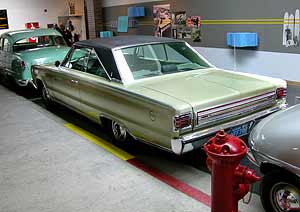 As long as he lived, Bill Harrah was a street racer whose “sleepers” were notorious around Reno for engaging unsuspecting tourists in fast cars. In late 1965, he special-ordered one of the few 1966 Satellites ever assembled with both a 426 Hemi and air conditioning. Harrah’s other “driver” was a stock-appearing Jeep Grand Wagoneer—also on permanent display here—that concealed a Ferrari V-12! (Photo by Dave Wallace/Good Communications) |
More than 1000 of the rest were disposed of in a record-setting Kruse auction that generated some $41 million in three auction sessions, nearly a quarter of a century ago. The primary beneficiary of this unprecedented sell-off was Holiday Inns, which had acquired the cars—along with the rest of Harrah’s hospitality holdings—in February 1980. Hundreds of automotive enthusiasts benefited by getting an unexpected opportunity to bid on so many valuable cars, trucks and motorcycles. Incredibly, America’s greatest car collector left behind no specific instructions for his collection.
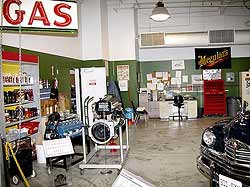 Vehicles are repaired and serviced on site, in full view of museum visitors. Some are loaned out for special events, requiring them to be kept in perfect running condition. (Photo by Dave Wallace/Good Communications) |
“Nearly 1500 cars was too large a collection for anyone, even Bill Harrah, to look after and display,” in the opinion of historian Foster. “I am told that many of them were simply warehoused or even left out in the (admittedly-fairly-benign) Nevada elements. Thus, the auction sell-off actually put many of these cars back into circulation, in the hands of people who would love them individually and, hopefully, restore them or at least use them.”
In his definitive Harrah biography, “William Fisk Harrah: The Life And Times Of A Gambling Magnate”, Doubleday, author Leon Mandel revealed that Harrah’s seventh and last wife, Verna, had urged her husband to add a provision to his will preventing whoever acquired his company from selling the collection:
“’I’d never do that,’ he answered. ‘That’s my thing, not theirs. They should be able to do whatever they want.’”
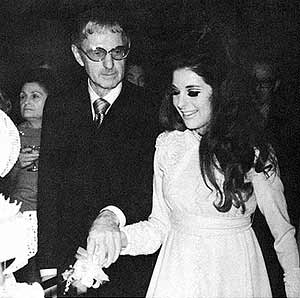 The fourth (of seven!) Mrs. Harrahs was singer-songwriter Bobbie Gentry, whose sole country-crossover hit, “Ode To Billy Joe”, is still heard on the radio. The marriage didn’t last as long: Only four months after this 1969 cake-cutting ceremony, the odd couple separated. |
“Verna was incredulous. ‘You’d sell those cars?’”
“’Yeah, but I’d probably start all over.’”
The late Mandel, a longtime Reno resident and the universally-respected editor of Autoweek, was among the journalists and civic leaders who led the charge to (A) persuade Holiday Corporation to donate some of the most-important vehicles to a permanent museum and (B) solicit donations of sufficient money and real estate to erect and maintain a new home for the survivors. A nonprofit organization was formed and, eventually, raised approximately $10 million. Finally, in 1989, the National Automobile Museum opened across the street from Harrah’s Hotel. The single-level building boasts 105,000 square feet of display space and more than 200 cars, trucks and motorcycles representing the entire existence of the automobile, including significant race cars. Two survivors from the original collection are Don Prudhomme’s world-beating 1975 Monza and Don Garlits’ late-1974-model fueler, which was seen mostly at AHRA Grand American Series events, and helped clinch the AHRA points championship.
|
ADVERTISEMENT  |
“It was not a good car,” e-mails Garlits about one of his few surviving dragsters not spending its retirement in Ocala, Fla. “I only ran it several times before Bill Harrah called and wanted to buy it. I sold him Swamp Rat 20 over the phone, after a visit to his museum during 1974. He wanted a Garlits car and agreed to take one that did not run. He generally wanted all his exhibits to run as they did when they were in service. He sent a truck to Seffner and picked up the car as a static display. The price was $7,500. He didn’t lose on that deal!”
Besides involving one of the few non-operational cars in the original collection, Garlits’ transaction was atypical in that the buyer revealed himself prior to sealing the deal. Typically, Harrah would dispatch an agent to inspect and make an offer on a vehicle; only after it went on display did many former owners learn the true identify of the new owner. Although he’d been driving since age eight (!) and owned more than 325 cars by 1962, when the Harrah Automobile Collection opened to the public, another decade passed before Harrah began pressuring the scouts he paid to scan classified ads in newspapers throughout the nation. His goal became nothing less than acquiring one of every type of car ever manufactured!
People who knew him at the time have speculated that this quest intensified after the Mayo Clinic’s 1972 discovery of an aneurysm, and subsequent heart surgery to repair it. He was told by Mayo surgeons that a follow-up operation would probably be necessary five or six years down the road—and that his chances of surviving a second surgery would not be good (with the medical technology then available).
|
Contact: Jackie Frady, Executive Director, National Automobile Museum; (775) 333-9300; www.automuseum.org |
Fewer than 60 vehicles remained on Harrah’s wish list when that dire prediction came true, right on schedule, at the Mayo Clinic in Minnesota. Meanwhile, he’d purchased a large piece of property alongside Interstate 80 for the 1400-plus machines then warehoused in nearby Sparks. His collection was envisioned as the heart of a huge resort complex to be called Harrah’s World. That dream died with the man, but the vehicles that survived should serve to keep William Fisk Harrah’s true legacy alive as long as other “car guys” keep coming to Reno.
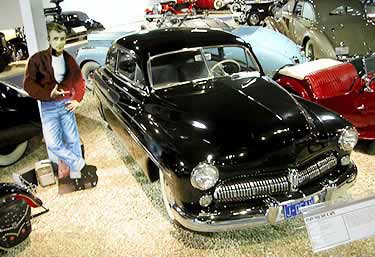 The mild Barris custom wheeled by James Dean in 1955’s “Rebel Without A Cause” is the vehicle most-often requested for outside events, according to museum staffers. The young actor’s premature death and best-known film both reach the half-century mark next year, so you’ll be hearing a lot more about him—beginning with exclusive grand-opening coverage of the new James Dean Gallery (Marion, Ind.) in next month’s Drag Racing Online. (Photo by Dave Wallace/Good Communications) |
![]()
 |
||
Copyright 1999-2004, Drag Racing Online and Racig Net Source